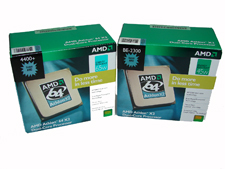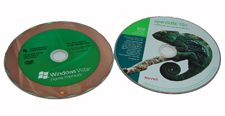RAM, CPU, and OS
Our selection of memory was yet another difficult choice as the prices for high quality DDR2-800 memory is almost absurd at this time. We mean that in a good way as a year ago the prices were absurdly high at this time. In the end, we decided upon the
Patriot eXtreme Performance DDR2-800 2GB kit,
SUPER TALENT DDR2-800 2GB kit, and the
OCZ Reaper HPC 2GB kit as our memory selections. However, due to recent price reductions we would not hesitate recommending the
Crucial or
G.Skill DDR2-800 2GB kits. Our base configuration for each of our platform setups consists of 2GB but all boards with be additionally tested with a 4GB configuration in both stock and overclocked conditions to ensure compatibility with four DIMMs.
 |
The price war between Intel and AMD continues unabated at this time. While that is very good for consumers, it has made our choice of processors difficult to nail down for testing. Our initial choice was the AMD X2 3800+ versus the Intel E2140, but with the recent price reductions and the elimination of the X2 3800+ from AMD's product roadmap we ended up pairing the AMD Athlon 64 X2 4400+ against the Intel E2160 for our main test results. Both CPUs are priced right around the $85~$90 range and as you will see they offer great performance for the dollar. When we get to the platform testing we will provide additional results with the AMD X2 BE-2300 Energy Efficient CPU, AMD Athlon X2 6000+, Intel E6320 Core 2 Duo, and the Intel Q6600 Quad Core for our ultimate budget gaming system.
 |
The Operating System decision actually turned out to be fairly easy. We still use Windows XP on a daily basis in most of our systems but we have already switched over to Vista for our motherboard testing. Unfortunately, we have been using Vista Ultimate 64-bit but that particular version of Vista just did not make sense at this time for our budget minded µATX roundup. We chose Vista Home Premium 32-bit as our operating system of choice. Not only do most OEM systems ship (often exclusively) with Vista but generally the consumer machines come preloaded with Vista Home Premium 32-bit for compatibility reasons. Whether we like it or not, Vista is the future for Windows based machines so our configuration reflects this trend. The use of Microsoft's latest OS will also serve as a good indication of how up-to-date motherboard manufacturers are in the driver department.
Our other operating system choice is SUSE Linux 10.2. We have received countless requests asking about Linux compatibility on the motherboards we review so we decided to check it out for ourselves with a commercially available package. Our testing will not be as rigorous or extensive as our standard Windows test routines. In fact, let's just say our initial foray into the world of Linux will mostly consist of checking compatibility and driver support at this time. We will provide our results at the very end of the roundup and hopefully our experiences will be helpful for those first time Linux users. (While we're really not interested in starting up a lengthy discussion of which distro is best, if
you are then feel free to
head over to the forums.)













42 Comments
View All Comments
Mazen - Monday, August 27, 2007 - link
If memory serves me well, we were supposed to see something last week!Mikus42 - Thursday, August 16, 2007 - link
You have great timing! I am researching components for a Micro ATX box.I have an older Shuttle SFF I am going to replace. (It is topped out on CPU speed.)
For me, noise is a very important factor. My shuttle is on my desktop and it can be a tad noisy.
jonp - Thursday, August 9, 2007 - link
The SG03 case is $160 (Newegg) w/o a power supply....ouch.The SX6 w/600w case is $112 (eCost).
I would like to nominate the Foxconn TLM776-CN300C-02 w/300w at $40 (Newegg) as a more typical mini-tower case option.
2 5.25" external -- one more than SG03; same as SX6.
2 3.5" external -- one more than both SG03 and SX6.
4 3.5" internal -- two more than both SG03 and SX6.
expansion slots, front ports same for all three.
power & reset buttons (SX6 yes; not sure if SG03 has reset button).
1 80mm exhaust fan (SG03: 120mm intake, no exhaust; SX6 80mm intake, 120mm exhaust)
Steel (SG03 Al; SX6 steel(?))
The TLM776 power supply is a Channel Well unit. If that doesn't suit then it can be replaced with say a Seasonic S12 II 330watt at $60 for $100 total.
RamIt - Wednesday, August 8, 2007 - link
I am so dissapointed by the numerous delays with this article, i will just pass it up when it finally materalizes. Way too many broken promises Gary.Peace out.
SanLouBlues - Wednesday, August 8, 2007 - link
Since you're dipping your toes in, I'm dying to see some reviews of the PCHDTV cards for linux that claim ATSC/NTSC and unencrypted QAM support.carver5678 - Wednesday, August 8, 2007 - link
here are some suggestions for the review:(1) measure northbridge temps. *lots* of people are having problems with hot NBs. for example, see customer reviews on newegg product pages.
(2) evaluate the ability of the boards to support passive cooling. can the scythe ninja fit on the motherboard? does the board rely on airflow from a cpu cooler to cool its northbridge? can it fit a scythe ninja, thermaright hr-05 NB heatsink, and thermaright hr-03 VGA heatsink, all at the same time, or do they conflict with each other?
lopri - Wednesday, August 8, 2007 - link
I am 200% for the AT's (newer) stance on motherboard evaluations. Contrary to common myth, enthusiast market is HUGE. In various forums I often hear arguments like "Vendors make most money from OEM contracts", "They don't care about enthusiasts. They make money off server market", etc. - this can't be wrong enough. As computers are becoming a commodity, the number of enthusiasts is getting bigger, and vendors are very well aware of this fact. These days we observe even the most conservative and OEM-oriented companies attempt to jump in this growing market and have a piece.And there come the inevitable side-effects: Rushed-out (i.e. bug-fest) products, irrelevant blings, non-functional features, unacceptable compatibility, and poor longevity, etc.
The #1 components in PC, of the said side-effects, are by far motherboards. I have been really put off by today's motherboards and for me it totally ruined the image of "Intel Stability". In all honesty, if I were to be responsible for an on-going support of an Intel based system, there would be only select a few 975X boards to choose from – of course in order to avoid potential hassles . It has been that bad, IMHO, and the ways vendors handle their mishaps are infuriating sometimes. Anyone who had to deal with the so-called "tech support" of famed motherboard manufacturers would know. Even under the best case of scenario, users have to deal with 2~3 weeks of downtime for replacement. (maybe except EVGA) For me, it's a total nonsense.
If you buy a TV, you most likely expect it to work as advertised. Same for a DVD player, refrigerator, or anything that you spend your hard-earned cash on. Not so for a motherboard. It's been such a mystery for me (who happen to be dealing with many professionals and their works/products) how these Taiwanese mobo manufacturers can get away with the poor quality of products they dump in the market, and their shady business practices. When I purchase a product, I should be able to expect a 100% defect-free product, instead of praying on luck. I also don't want to see a almost same product as I bought, being sold with a slightly different name and fixed functions, not too long after my purchase.
To a certain extent, I blame online journalist for their negligence. I do understand many are working with the manufacturers directly to get things right for us and that alone could be a reason why they often are sympathetic with the manufacturers. However, it is important to note that ultimately, reviewers should be in the buyer's shoes, and articles from reputable reviewers can have a huge effect on buyers' decisions. No matter how much work a mobo manufacturer put in, and no matter how much they listened to the reviewers, if the final products that end-users get are not up to the standard (read: 100% free from , reviewers should clearly state the shortcomings of the products at hand.
Above said, I felt so refreshed reading from the first page of this article and would like to commend AT's courage. It's not that AT has been partial or unfair until today - it's the opposite. AT's motherboard reviews are probably the only motherboard reviews (and TechReport's) I've trusted to date and often times I don't even bother to read any other site's reviews. (they are waste of my time) I couldn't be happier with every single sentence that Gary wrote in a clear English. It read almost like a 'motherboard review manifesto 2007' :D and I couldn't agree more with every single word he stated.
SunLord - Wednesday, August 8, 2007 - link
I sure as hell hope you have no plans to recommend the Mx5000 desktop to anyone. It's an unstable pile of crap. The keyboard at random times goes nuts and keys "stick" as you type. They don't stick down but they just keep repeating in windows cause the keyboard has dropped it's signal it's a bluetooth/site point problem. Oh andf can't forget the battery life gotta remember to always turn it off or you'll be replacing batteries every other week. The mouse is nice though.I'm buying a G15 and a rf wireless mouse to replace my month old Mx5000 because it's not worth the hassle of having to pull out and replug in the bt adapter every time the keyboard takes a dump
strikeback03 - Wednesday, August 8, 2007 - link
We have a MX5000 set at work and I have one at home. On the work set it has never dropped the connection, and we have replaced the batteries twice in 15 months (and it sees use for a couple hours a day). The only major problem is that the Logitech software can't handle switching between Linux and Windows, which is why on my home computer I didn't install the Logitech software. I use my home keyboard more, and still get 3 months or so out of decent rechargable batteries.SunLord - Wednesday, August 8, 2007 - link
I exchanged one set after a week and this one is still flacky i just moved to linux 3days ago and while bluetooth is useless it works perfectly. So I'd have to say it's all logitechs fault with there typical craptastic driversOn batteries no clue I burned through 8batteries in a month i bought the same day i got the keyboard at BB... Nice new duracells